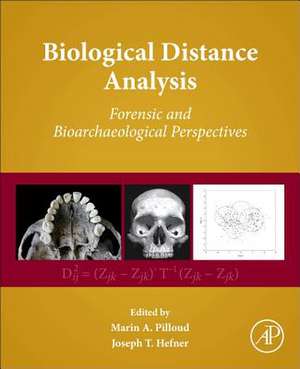Biological Distance Analysis: Forensic and Bioarchaeological Perspectives
Editat de Marin A. Pilloud, Joseph T. Hefneren Limba Engleză Hardback – 27 iul 2016
The final section concentrates on population-based bioarchaeological approaches, providing key techniques and examples from archaeological samples. The volume also includes an appendix with additional resources available to those interested in biological distance analyses.
- Defines datasets and how they are used within biodistance analysis
- Applies methodology to individual and population studies
- Bridges the sub-fields of forensic anthropology and bioarchaeology
- Highlights current research and future directions of biological distance analysis
- Identifies statistical programs and datasets for use in biodistance analysis
- Contains cases studies and thorough index for those interested in biological distance analyses
Preț: 453.12 lei
Preț vechi: 575.62 lei
-21% Nou
Puncte Express: 680
Preț estimativ în valută:
86.71€ • 94.16$ • 72.84£
86.71€ • 94.16$ • 72.84£
Carte tipărită la comandă
Livrare economică 15-29 aprilie
Preluare comenzi: 021 569.72.76
Specificații
ISBN-13: 9780128019665
ISBN-10: 0128019662
Pagini: 518
Dimensiuni: 191 x 235 x 29 mm
Greutate: 1.1 kg
Editura: ELSEVIER SCIENCE
ISBN-10: 0128019662
Pagini: 518
Dimensiuni: 191 x 235 x 29 mm
Greutate: 1.1 kg
Editura: ELSEVIER SCIENCE
Cuprins
Section 1. Biodistance Data, Datasets, and Analytical Methods
Chapter 1. A Brief History of Biological Distance Analysis
Chapter 2. Biological Distances and Population Genetics in Bioarchaeology
Chapter 3. Craniometric Data Analysis and Estimation of Biodistance
Chapter 4. Advanced Methods in 3-D Craniofacial Morphological Analysis
Chapter 5. Cranial Nonmetric and Morphoscopic Data Sets
Chapter 6. Dental Morphology in Biodistance Analysis
Chapter 7. Dental Metrics in Biodistance Analysis
Chapter 8. Do Biological Distances Reflect Genetic Distances? A Comparison of Craniometric and Genetic Distances at Local and Global Scales
Chapter 9. Missing Data Imputation Methods and Their Performance With Biodistance Analyses
Section 2. Biodistance in a Forensic Setting
Chapter 10. Forensic Classification and Biodistance in the 21st Century: The Rise of Learning Machines
Chapter 11. Forensic Ancestry Assessment Using Cranial Nonmetric Traits Traditionally Applied to Biological Distance Studies
Chapter 12. Biological Distance, Migrants, and Reference Group Selection in Forensic Anthropology
Chapter 13. The Craniometric Implications of a Complex Population History in South Africa
Chapter 14. Complexity of Assessing Migrant Death Place of Origin
Chapter 15. Estimating Ancestry of Fragmentary Remains Via Multiple Classifier Systems: A Study of the Mississippi State Asylum Skeletal Assemblage
Chapter 16. Biological Distance Analysis, Cranial Morphoscopic Traits, and Ancestry Assessment in Forensic Anthropology
Chapter 17. Dominance in Dental Morphological Traits: Implications for Biological Distance Studies
Section 3. Biodistance and Population Studies
Chapter 18. Postmarital Residence Analysis
Chapter 19. Population Structure During the Collapse of the Moche (AD 200–850): A Comparison of Results Derived From Deciduous and Permanent Tooth Trait Data From San José de Moro, Jequetepeque Valley, Perú
Chapter 20. Alternate Methods to Assess Phenetic Affinities and Genetic Structure Among Seven South African “Bantu Groups Based on Dental Nonmetric Data
Chapter 21. Crossroads of the Old World: Dental Morphological Data and the Evidence for a Eurasian Cline
Chapter 22. A Baffling Convergence: Tooth Crown and Root Traits in Europe and New Guinea
Chapter 23. Population Biodistance in Global Perspective: Assessing the Influence of Population History and Environmental Effects on Patterns of Craniomandibular Variation
Chapter 24. A Biodistance Analysis of Mandibles From Taiwan, Asia, and the Pacific: A Search for Polynesian Origins
Chapter 25. The Biocultural Evolution in the Osmore Valley: Morphological Dental Traits in Pre-Inca Populations
Chapter 1. A Brief History of Biological Distance Analysis
Chapter 2. Biological Distances and Population Genetics in Bioarchaeology
Chapter 3. Craniometric Data Analysis and Estimation of Biodistance
Chapter 4. Advanced Methods in 3-D Craniofacial Morphological Analysis
Chapter 5. Cranial Nonmetric and Morphoscopic Data Sets
Chapter 6. Dental Morphology in Biodistance Analysis
Chapter 7. Dental Metrics in Biodistance Analysis
Chapter 8. Do Biological Distances Reflect Genetic Distances? A Comparison of Craniometric and Genetic Distances at Local and Global Scales
Chapter 9. Missing Data Imputation Methods and Their Performance With Biodistance Analyses
Section 2. Biodistance in a Forensic Setting
Chapter 10. Forensic Classification and Biodistance in the 21st Century: The Rise of Learning Machines
Chapter 11. Forensic Ancestry Assessment Using Cranial Nonmetric Traits Traditionally Applied to Biological Distance Studies
Chapter 12. Biological Distance, Migrants, and Reference Group Selection in Forensic Anthropology
Chapter 13. The Craniometric Implications of a Complex Population History in South Africa
Chapter 14. Complexity of Assessing Migrant Death Place of Origin
Chapter 15. Estimating Ancestry of Fragmentary Remains Via Multiple Classifier Systems: A Study of the Mississippi State Asylum Skeletal Assemblage
Chapter 16. Biological Distance Analysis, Cranial Morphoscopic Traits, and Ancestry Assessment in Forensic Anthropology
Chapter 17. Dominance in Dental Morphological Traits: Implications for Biological Distance Studies
Section 3. Biodistance and Population Studies
Chapter 18. Postmarital Residence Analysis
Chapter 19. Population Structure During the Collapse of the Moche (AD 200–850): A Comparison of Results Derived From Deciduous and Permanent Tooth Trait Data From San José de Moro, Jequetepeque Valley, Perú
Chapter 20. Alternate Methods to Assess Phenetic Affinities and Genetic Structure Among Seven South African “Bantu Groups Based on Dental Nonmetric Data
Chapter 21. Crossroads of the Old World: Dental Morphological Data and the Evidence for a Eurasian Cline
Chapter 22. A Baffling Convergence: Tooth Crown and Root Traits in Europe and New Guinea
Chapter 23. Population Biodistance in Global Perspective: Assessing the Influence of Population History and Environmental Effects on Patterns of Craniomandibular Variation
Chapter 24. A Biodistance Analysis of Mandibles From Taiwan, Asia, and the Pacific: A Search for Polynesian Origins
Chapter 25. The Biocultural Evolution in the Osmore Valley: Morphological Dental Traits in Pre-Inca Populations
Recenzii
"...an excellent tool for both researchers who are new to the field of biodistance, and those looking to further their knowledge on available techniques and recent research questions." --Assemblage
